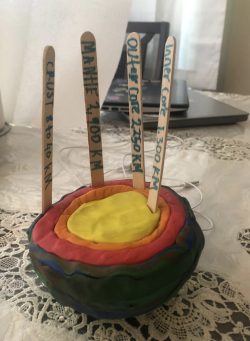In pre-pandemic times, Seattle MESA coordinators Martha Flores Pérez and Brian Tracey could be found in six high schools and five middle schools in the Mukilteo, Seattle and Tukwila school districts, supplementing science and math classes with hands-on learning to expose students to the joys and excitement of STEM (science, technology, engineering and math). The goal of the program is to build a pipeline for students from communities that have been historically underrepresented in the sciences to pursue STEM in universities and professionally, and to help develop their identities as scientists.
Then the pandemic hit, and the Seattle MESA team was forced to completely rethink the program while trying to support teachers also rethinking their lesson plans for the year. A big question was: how can science still be engaging and hands-on while taught through a computer screen in a completely virtual environment?

Flores Pérez and Tracey tried different online tools, but they lacked the hands-on component foundational to the MESA program. With donations from organizations such as the Bezos Family Foundation, they put together “MESA kits” focusing on STEM education through hands-on projects. Students received kits with Arduino microcontrollers and robot parts that could be built into functioning robots and sensors, and the MESA coordinators worked with the students on robot assembly during class time, answering questions and talking about the mechanics.
Students were encouraged to fully immerse themselves into the projects – to play around with their kits and not be afraid to fail or break something. MESA developed different kits too, including a module on earth science using inexpensive, readily available materials like popsicle sticks, foam and clay to model the different layers of the earth, and another that focuses on the environment and how to design smart cities.

Seattle MESA Director Peter Abe noted that excitement for the robot kits was contagious, and students not participating in the classes asked to join when they saw their classmates’ robots. Flores Pérez noticed something similar. “I’m hearing that the students are telling their friends and family about the things that they are learning, and that’s what STEM is all about: sharing,” she says. “It’s nice to have something concrete amongst the ambiguity.”
Lesson plans are up to the teachers, and the MESA coordinators meet with each instructor to identify goals for the school year and make sure their projects are complementary. All lessons are centered around the theme of identity, to make sure they are compelling and useful for students. For example, in schools with Latin American students, Flores Pérez taught the students about how Mayans used math, showing them that their heritage also is deeply rooted in STEM.
“The cool thing about the teachers we work with is that they are very flexible and vocal about the kind of support they need,” says Flores Pérez. “They see the value in the work we do, and make the students feel like they are a part of that.”
Feedback has been positive amongst students who have been attending virtual classes. But many students are not attending classes and this learning gap will pose a challenge once in-person classes resume. There’s also the issue of access; more than half of the students don’t have a computer or are sharing one computer per household, many have inadequate internet connectivity and speed, and others don’t have a quiet space to work and focus. On top of that, limited class time is cut even shorter with unexpected technological issues that arise and other technological restrictions. To help combat at least some of these problems, Seattle MESA delivered laptops to students and helped them get connected to the internet. Once they are online, MESA provides resources via newsletters sent out to parents and teachers.
Flores Pérez and Tracy are seeing the benefit they bring to the classroom and want Seattle MESA to continue being valuable, especially in this time of remote learning. “I want to be a resource and make sure I’m not overburdening the teachers. MESA is part of the College of the Environment and part of the University of Washington, where there is a wealth of knowledge. I encourage UW Environment and the UW community to reach out and not only see how they can contribute to MESA but vice versa,” says Flores Pérez.
Want to get involved? Flores Pérez encourages UW staff or students to volunteer with Seattle MESA. She notes that previous undergraduate volunteers have helped students with homework, and the students love seeing college students – especially if they are students of color.
Reach out to the Seattle MESA team for current volunteer opportunities.

